
The hardware and bandwidth for this mirror is donated by dogado GmbH, the Webhosting and Full Service-Cloud Provider. Check out our Wordpress Tutorial.
If you wish to report a bug, or if you are interested in having us mirror your free-software or open-source project, please feel free to contact us at mirror[@]dogado.de.

The goal of CytoProfile is to conduct quality control using biological meaningful cutoff on raw measured values of cytokines. Specifically, test on distributional symmetry to suggest the adopt of transformation. Conduct exploratory analysis including summary statistics, generate enriched barplots, and boxplots. Further, conduct univariate analysis and multivariate analysis for advance analysis.
Before installation of the CytoProfile package, make sure to install BiocManager and mixOmics packages using:
## install BiocManager
if (!requireNamespace("BiocManager", quietly = TRUE)) install.packages("BiocManager")
## install mixOmics
BiocManager::install('mixOmics')You can install the development version of CytoProfile from GitHub with:
# install.packages("devtools")
devtools::install_github("saraswatsh/CytoProfile")Install CytoProfile from CRAN with:
install.packages("CytoProfile")See change log for the latest updates and changes at News
Below are examples of using the functions provided in CytoProfile. Any saved or generated files that are PDF or PNG format will be found at in the Figures Folder.
# Loading all packages required
# Data manipulation and reshaping
library(dplyr) # For data filtering, grouping, and summarising.
library(tidyr) # For reshaping data (e.g., pivot_longer, pivot_wider).
# Plotting and visualization
library(ggplot2) # For creating all the ggplot-based visualizations.
library(gridExtra) # For arranging multiple plots on a single page.
library(ggrepel) # For improved label placement in plots (e.g., volcano plots).
library(pheatmap) # For heatmap.2, which is used to generate heatmaps.
library(plot3D) # For creating 3D scatter plots in PCA and sPLS-DA analyses.
library(reshape2) # For data transformation (e.g., melt) in cross-validation plots.
# Statistical analysis
library(mixOmics) # For multivariate analyses (PCA, sPLS-DA, etc.).
library(e1071) # For computing skewness and kurtosis.
library(pROC) # For ROC curve generation in machine learning model evaluation.
# Machine learning
library(xgboost) # For building XGBoost classification models.
library(randomForest) # For building Random Forest classification models.
library(caret) # For cross-validation and other machine learning utilities.
# Package development and document rendering
library(knitr) # For knitting RMarkdown files and setting chunk options.
library(devtools) # For installing the development version of the package from GitHub.
# Load in the CytoProfile package
library(CytoProfile)
# Loading in data
data("ExampleData1")
data_df <- ExampleData1# Generating boxplots to check for outliers for raw values
cyt_bp(data_df[, -c(1:3)], pdf_title = NULL)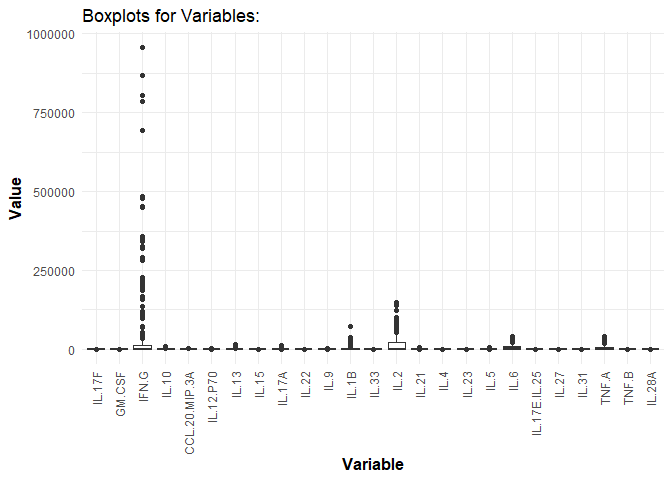
# Removing the first 3 columns to retain only continuous variables.
# Generating boxplots to check for outliers for log2 values
cyt_bp(data_df[, -c(1:3)], pdf_title = NULL, scale = "log2")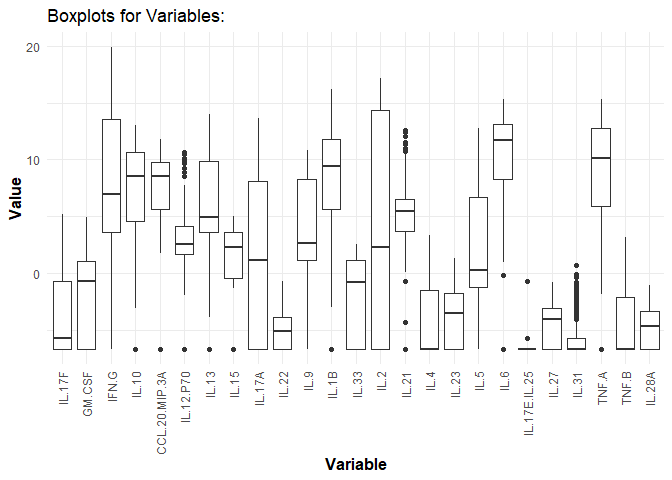
# Using log2 transformation for cytokine values.data_df <- ExampleData1[, -c(3, 5:28)]
data_df <- dplyr::filter(data_df, Group == "T2D", Treatment == "Unstimulated")
# Raw values for group-specific boxplots
cyt_bp2(data_df, pdf_title = NULL, scale = NULL)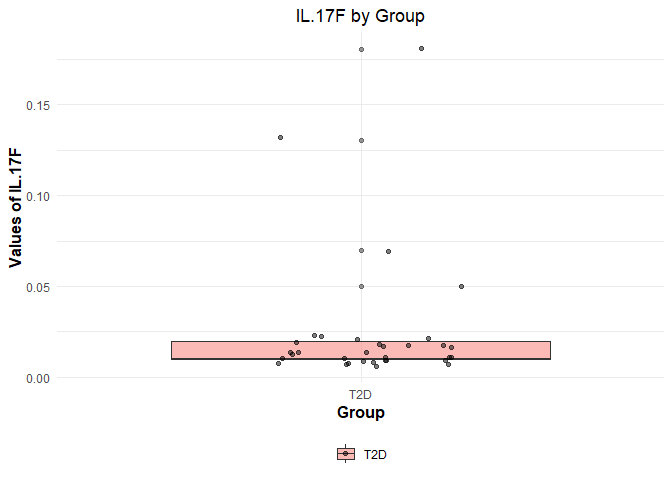

# Log2-transformed group-specific boxplots
cyt_bp2(data_df, pdf_title = NULL, scale = "log2")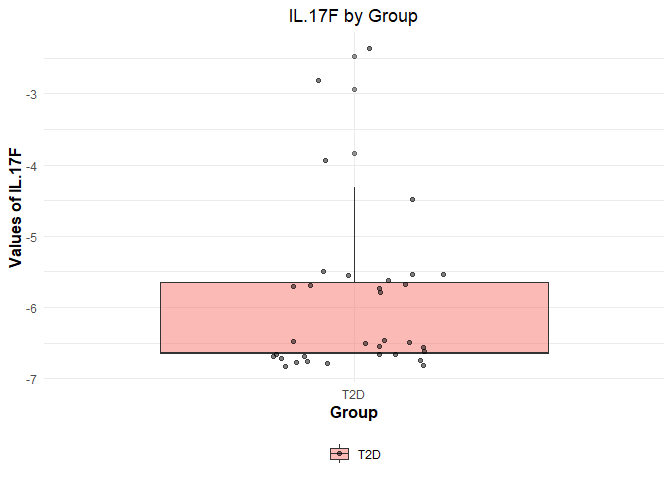
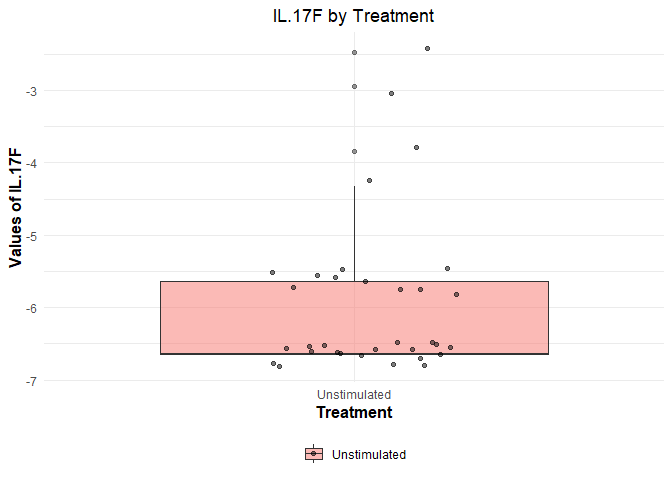
data_df <- ExampleData1
# Histogram of skewness and kurtosis for raw data
cyt_skku(data_df[, -c(1:3)], pdf_title = NULL, group_cols = NULL)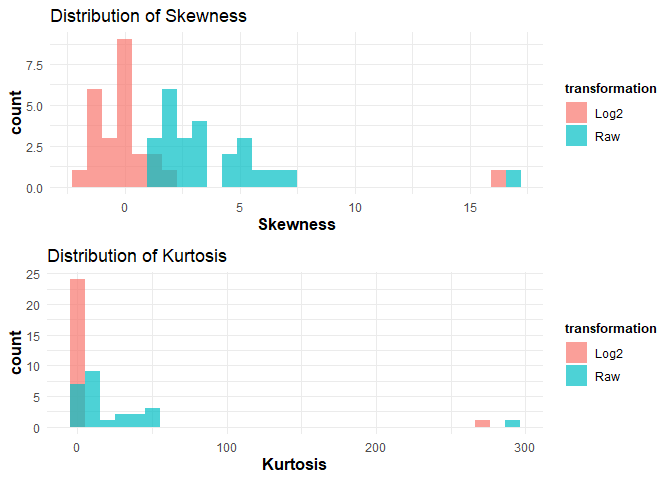
# Histogram of skewness and kurtosis with grouping (e.g., "Group")
cyt_skku(ExampleData1[, -c(2:3)], pdf_title = NULL, group_cols = c("Group"))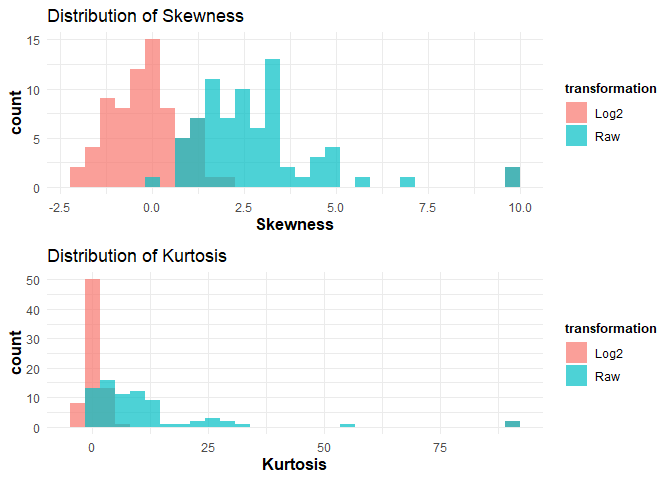
# Generating basic error bar plots
data_df <- ExampleData1
cyt_errbp(
data_df[, c("Group", "CCL.20.MIP.3A", "IL.10")],
group_col = "Group",
p_lab = FALSE,
es_lab = FALSE,
class_symbol = FALSE,
x_lab = "Cytokines",
y_lab = "Concentrations in log2 scale",
log2 = TRUE
)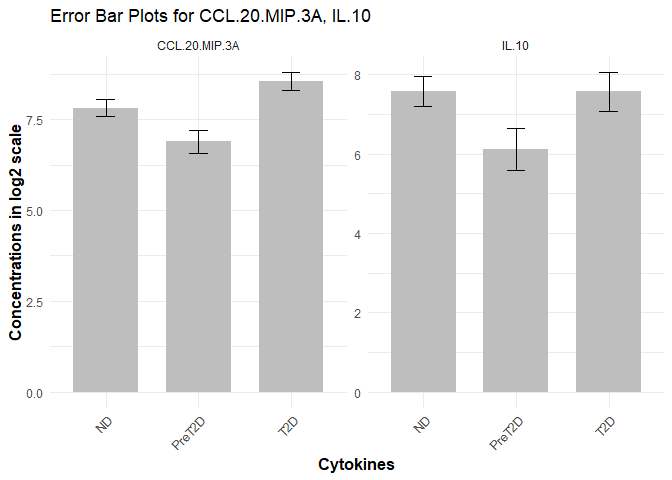
# Generating Error Bar Plot enriched with p-value and effect size
data_df <- ExampleData1
cyt_errbp(
data_df[, c("Group", "CCL.20.MIP.3A", "IL.10")],
group_col = "Group",
p_lab = TRUE,
es_lab = TRUE,
class_symbol = TRUE,
x_lab = "Cytokines",
y_lab = "Concentrations in log2 scale",
log2 = TRUE
)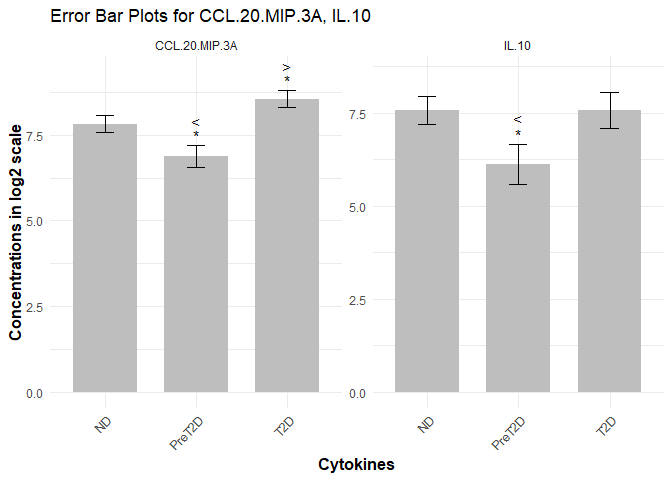
# Performing Test
data_df <- ExampleData1[, -c(3)]
data_df <- dplyr::filter(data_df, Group != "ND", Treatment != "Unstimulated")
# Test example
cyt_ttest(
data_df[, c(1:2, 5:6)],
scale = "log2",
verbose = TRUE,
format_output = TRUE
)
#> $results
#> Outcome Categorical Comparison
#> 1 IFN.G Group PreT2D vs T2D
#> 2 IL.10 Group PreT2D vs T2D
#> 3 IFN.G Treatment CD3/CD28 vs LPS
#> 4 IL.10 Treatment CD3/CD28 vs LPS
#> Test Estimate Statistic P_value
#> 1 Wilcoxon rank sum test with continuity correction -2.463 1599.0 0.008
#> 2 Wilcoxon rank sum test with continuity correction -0.956 1625.0 0.012
#> 3 Wilcoxon rank sum test with continuity correction 9.024 4132.5 0.000
#> 4 Wilcoxon rank sum test with continuity correction 1.690 3091.0 0.000# Perform ANOVA comparisons test (example with 2 cytokines)
data_df <- ExampleData1[, -c(3)]
cyt_anova(data_df[, c(1:2, 5:6)], format_output = TRUE)
#> Outcome Categorical Comparison P_adj
#> PreT2D-ND IFN.G Group PreT2D-ND 0.0883
#> T2D-ND IFN.G Group T2D-ND 0.9779
#> T2D-PreT2D IFN.G Group T2D-PreT2D 0.0550
#> PreT2D-ND1 IL.10 Group PreT2D-ND 0.7745
#> T2D-ND1 IL.10 Group T2D-ND 0.1546
#> T2D-PreT2D1 IL.10 Group T2D-PreT2D 0.0316
#> LPS-CD3/CD28 IFN.G Treatment LPS-CD3/CD28 0.0000
#> Unstimulated-CD3/CD28 IFN.G Treatment Unstimulated-CD3/CD28 0.0000
#> Unstimulated-LPS IFN.G Treatment Unstimulated-LPS 0.9988
#> LPS-CD3/CD281 IL.10 Treatment LPS-CD3/CD28 0.0000
#> Unstimulated-CD3/CD281 IL.10 Treatment Unstimulated-CD3/CD28 0.0000
#> Unstimulated-LPS1 IL.10 Treatment Unstimulated-LPS 0.0001# cyt_plsda function.
data <- ExampleData1[, -c(3)]
data_df <- dplyr::filter(data, Group != "ND" & Treatment == "CD3/CD28")
cyt_splsda(
data_df,
pdf_title = NULL,
colors = c("black", "purple"),
bg = FALSE,
scale = "log2",
ellipse = TRUE,
conf_mat = FALSE,
var_num = 25,
cv_opt = "loocv",
comp_num = 2,
pch_values = c(16, 4),
group_col = "Group",
group_col2 = "Treatment",
roc = TRUE
)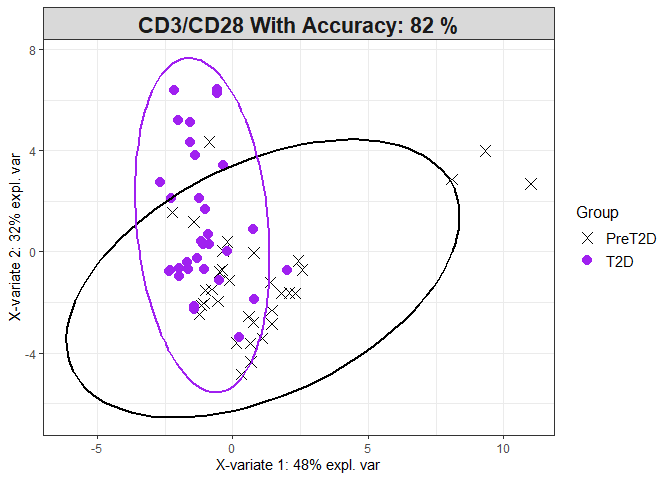
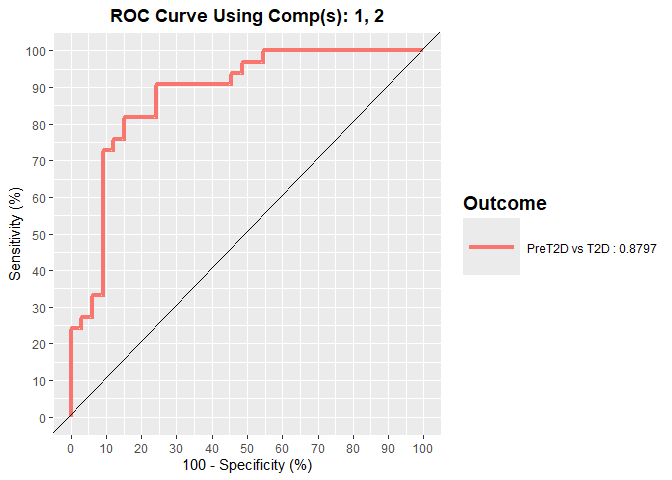
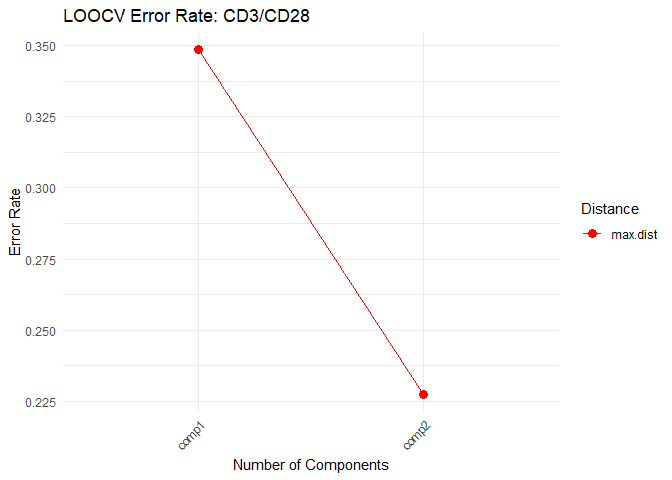
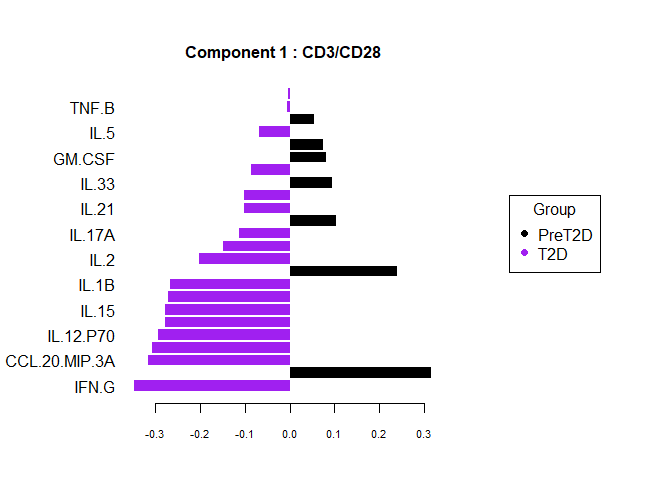
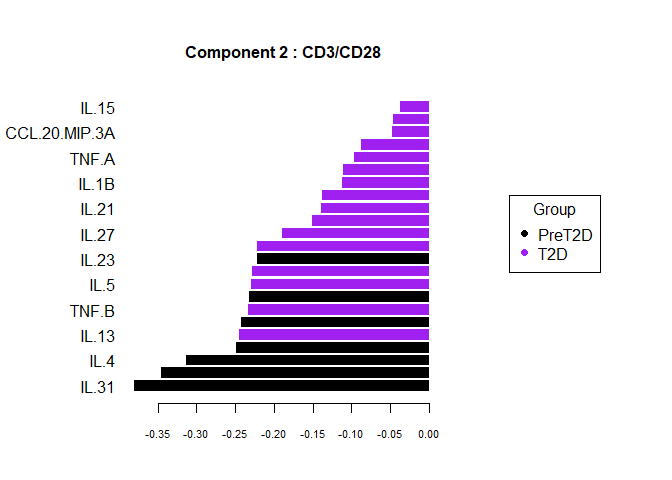
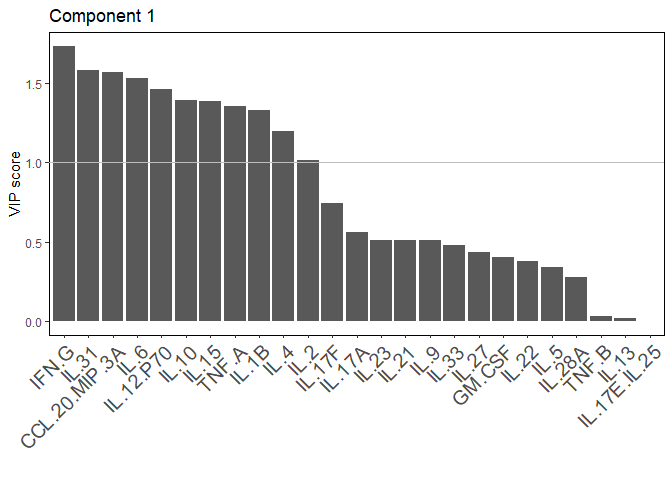
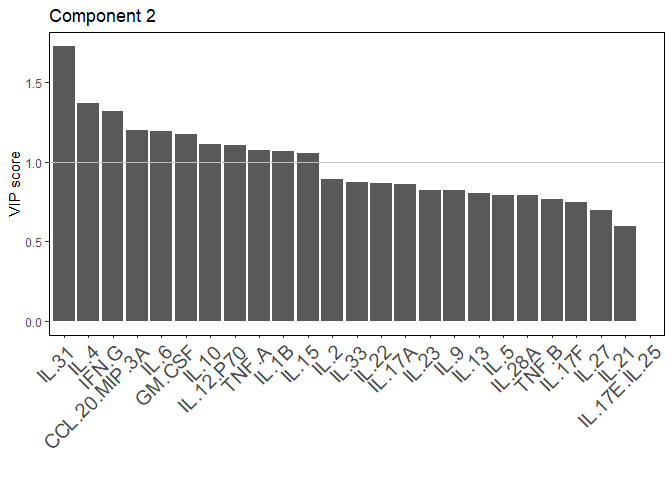
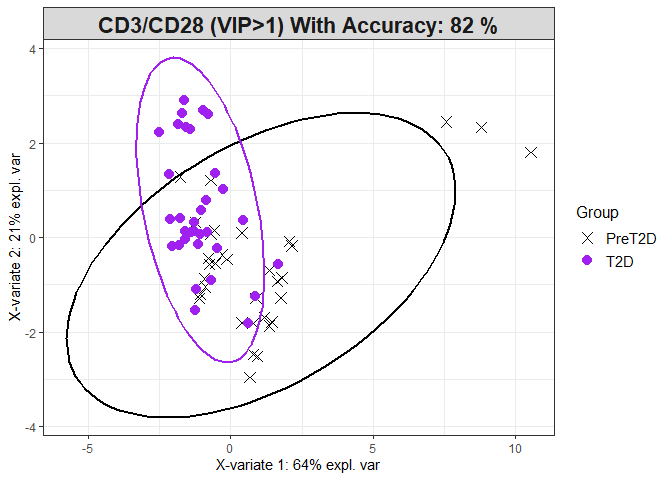
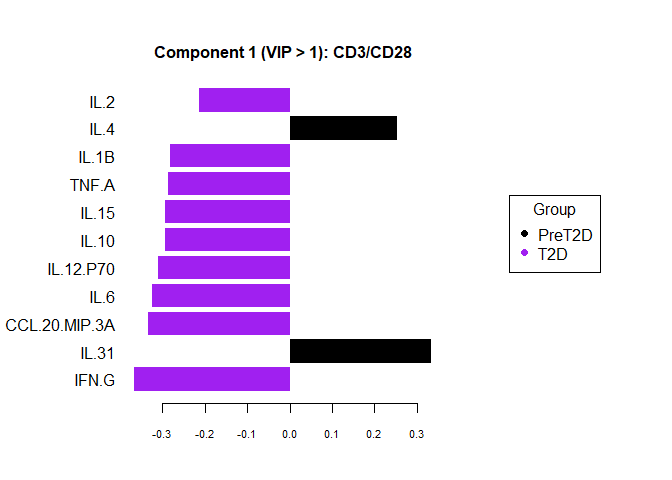


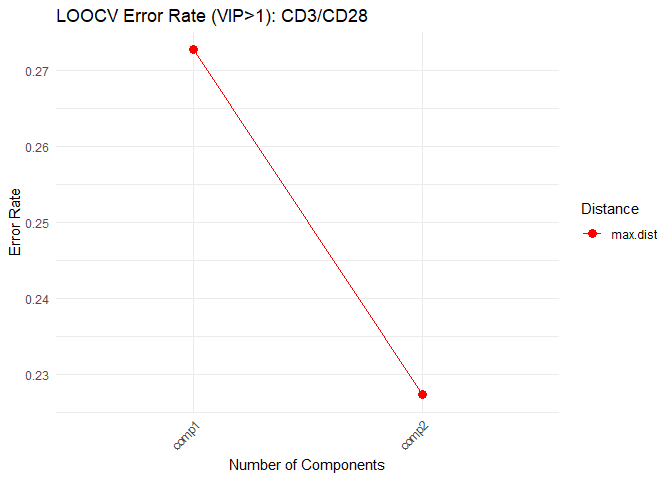
# cyt_mint_plsda function.
data_df <- ExampleData5[, -c(2, 4)]
data_df <- dplyr::filter(data_df, Group != "ND")
cyt_mint_splsda(
data_df,
group_col = "Group",
batch_col = "Batch",
colors = c("black", "purple"),
ellipse = TRUE,
var_num = 25,
comp_num = 2,
scale = "log2",
verbose = FALSE
)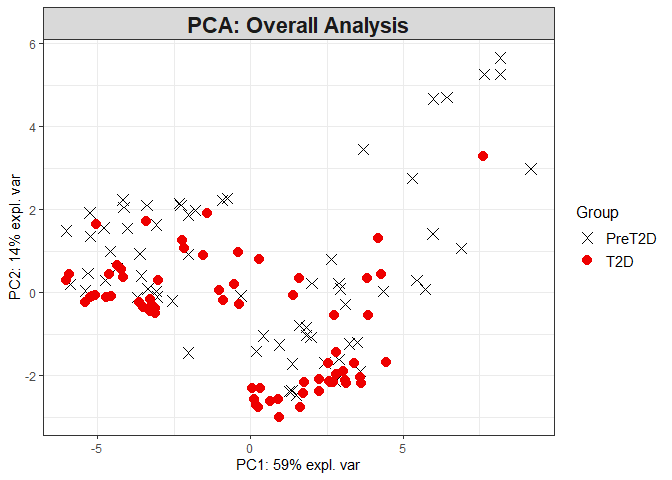
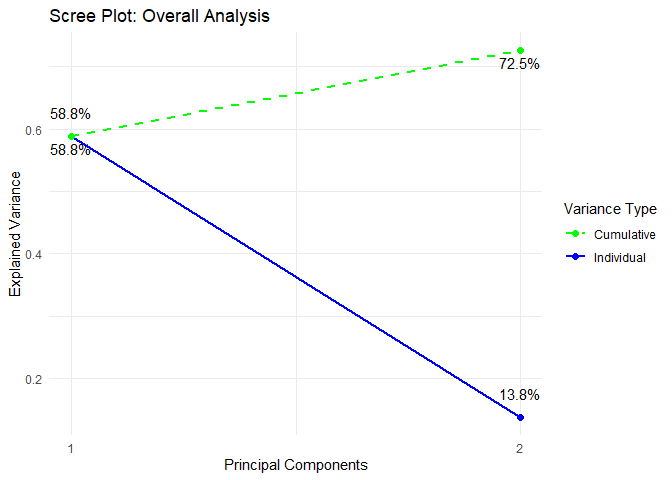

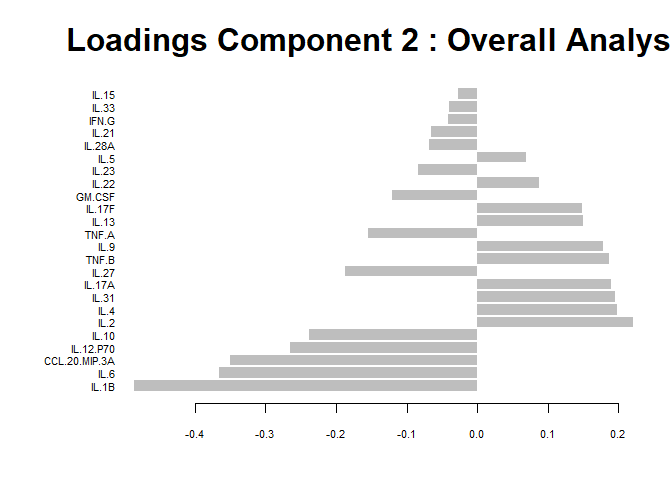
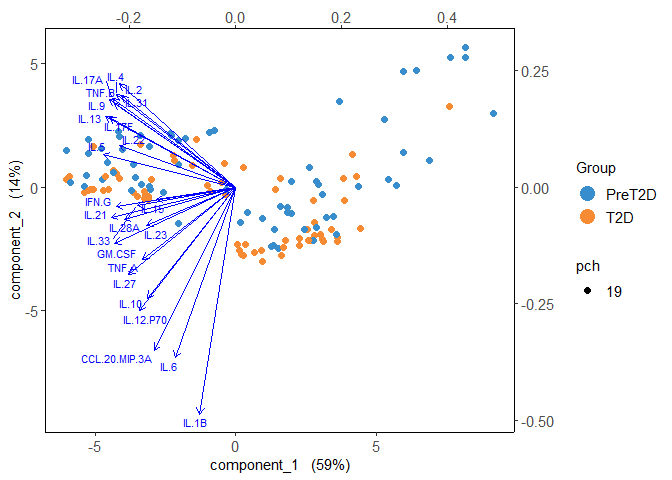
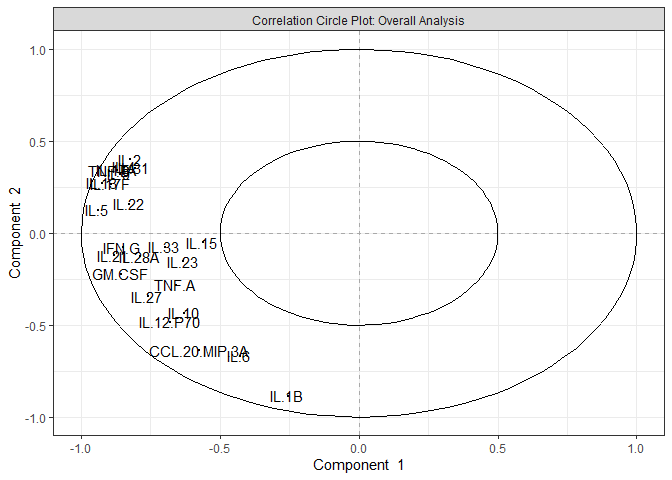
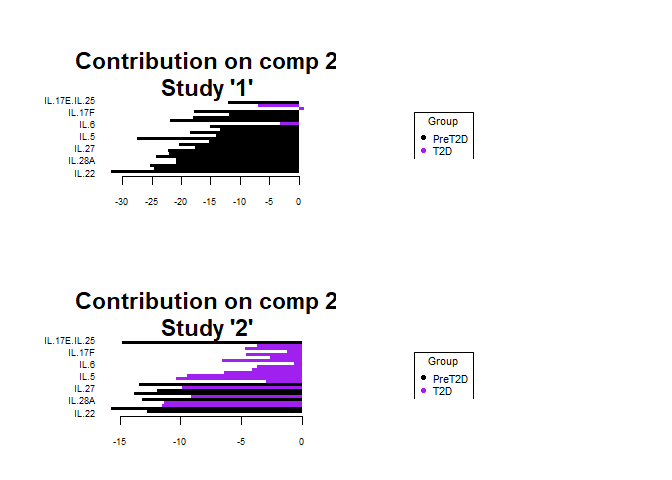
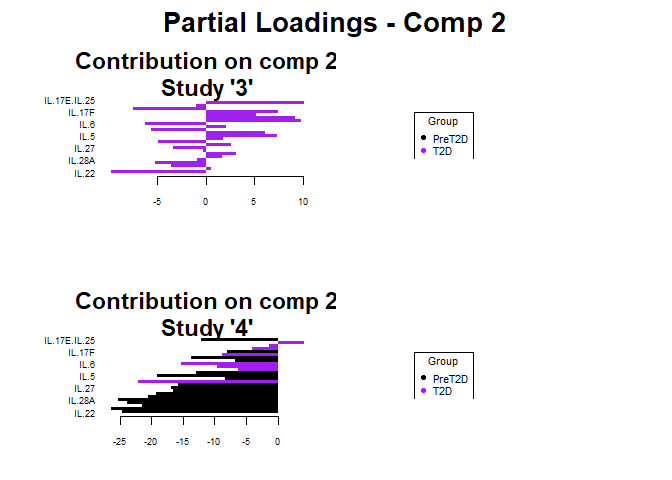
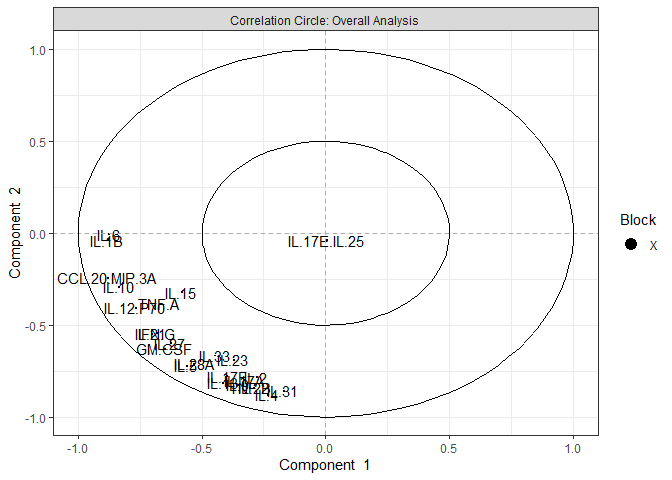
data <- ExampleData1[, -c(3, 23)]
data_df <- filter(data, Group != "ND" & Treatment != "Unstimulated")
cyt_pca(
data_df,
pdf_title = NULL,
colors = c("black", "red2"),
scale = "log2",
comp_num = 2,
pch_values = c(16, 4),
group_col = "Group"
)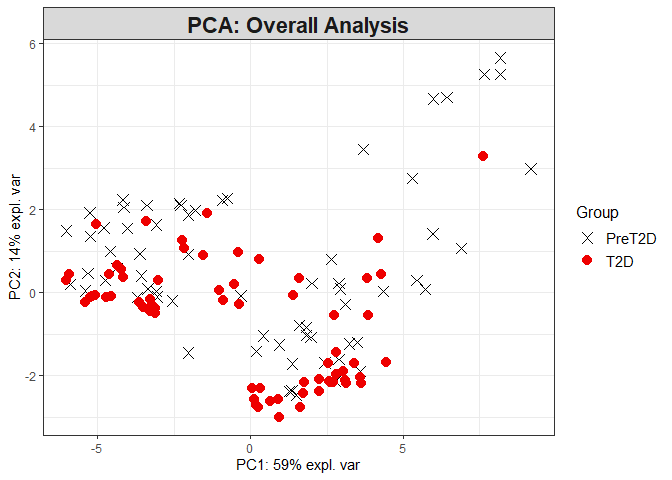
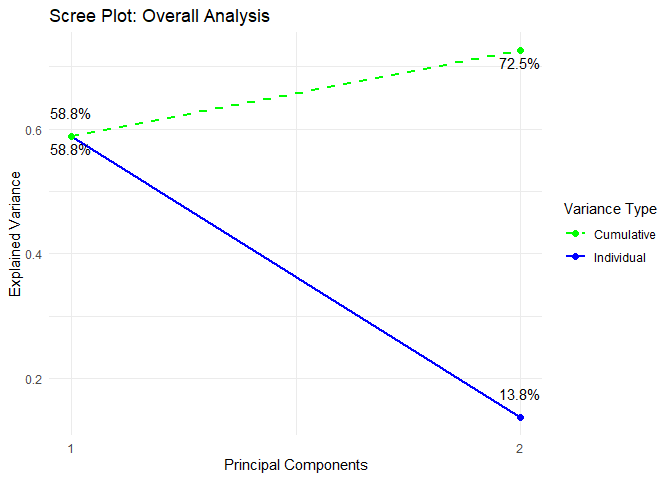
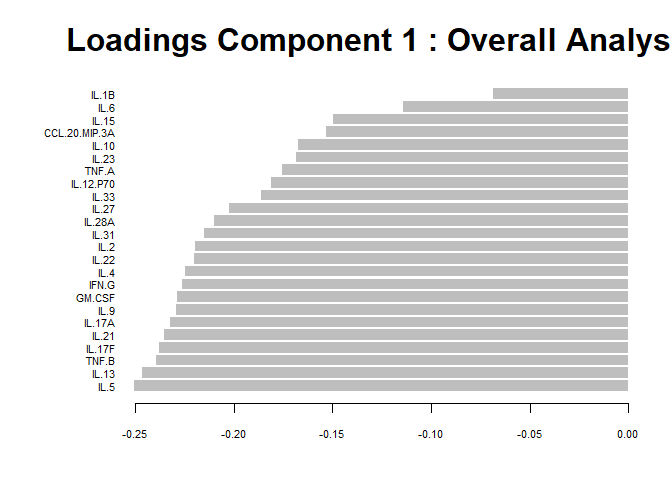
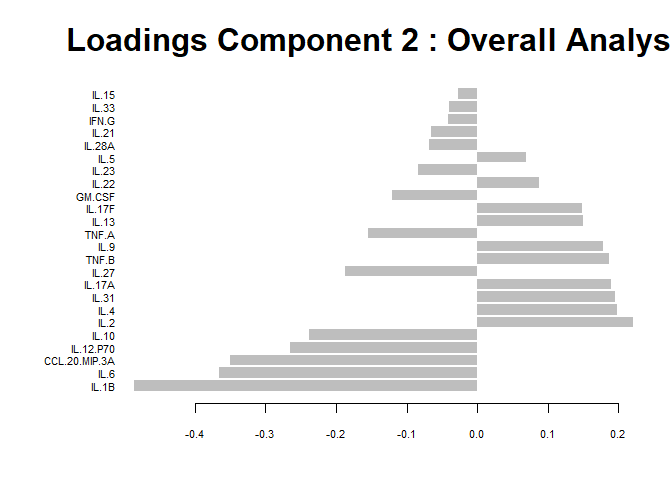
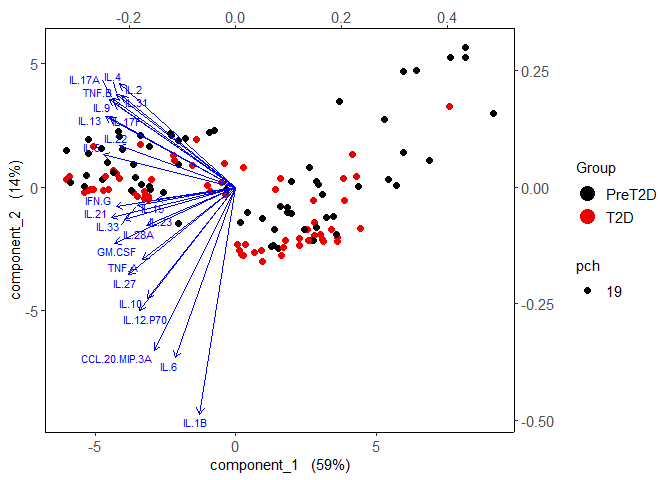
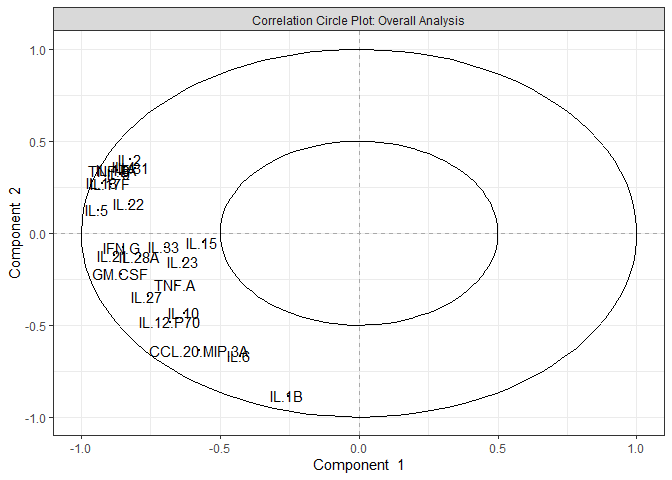
# Generating Volcano Plot
data_df <- ExampleData1[, -c(2:3)]
cyt_volc(
data_df,
group_col = "Group",
cond1 = "T2D",
cond2 = "ND",
fold_change_thresh = 2.0,
top_labels = 15
)
#> $`T2D vs ND`
# Generating Heat map
cyt_heatmap(
data = data_df,
scale = "log2", # Optional scaling
annotation_col = "Group",
title = NULL
)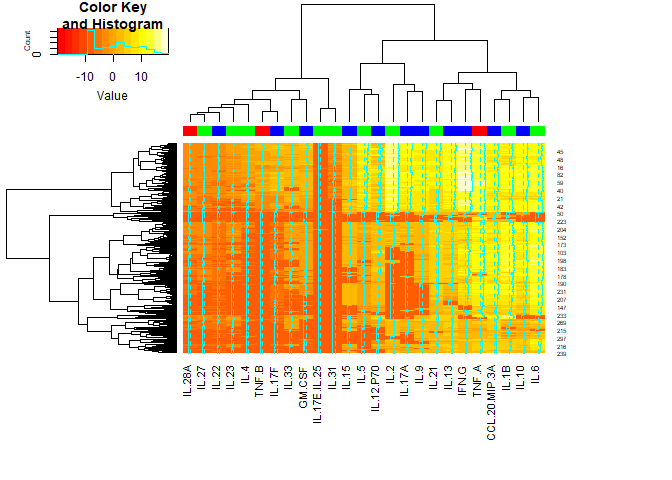
# Generating dual flashlights plot
data_df <- ExampleData1[, -c(2:3)]
dfp <- cyt_dualflashplot(
data_df,
group_var = "Group",
group1 = "T2D",
group2 = "ND",
ssmd_thresh = -0.2,
log2fc_thresh = 1,
top_labels = 10
)
# Print the plot
dfp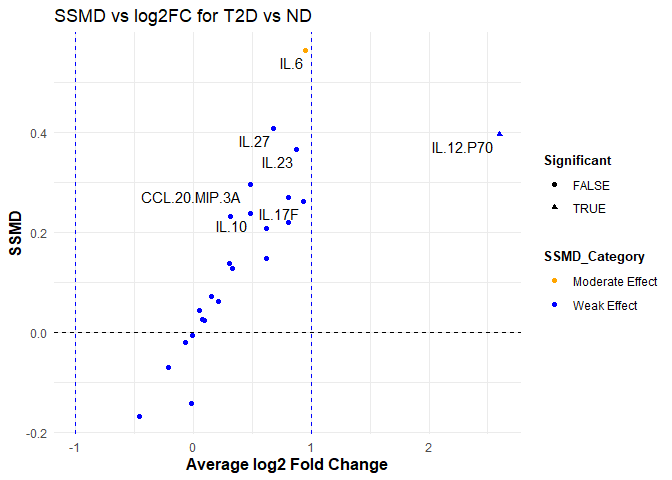
# Print the table data used for plotting
print(dfp$data, n = 25)
#> # A tibble: 25 × 11
#> cytokine mean_ND mean_PreT2D mean_T2D variance_ND variance_PreT2D
#> <chr> <dbl> <dbl> <dbl> <dbl> <dbl>
#> 1 CCL.20.MIP.3A 634. 404. 887. 6.72e+ 5 2.74e+5
#> 2 GM.CSF 2.65 3.11 1.92 2.63e+ 1 3.14e+1
#> 3 IFN.G 57730. 18303. 61484. 2.86e+10 2.30e+9
#> 4 IL.10 979. 836. 1366. 1.99e+ 6 1.19e+6
#> 5 IL.12.P70 13.0 39.1 78.9 4.15e+ 2 2.56e+4
#> 6 IL.13 1064. 1543. 1122. 5.60e+ 6 1.11e+7
#> 7 IL.15 7.92 4.29 8.22 3.54e+ 1 2.58e+1
#> 8 IL.17A 352. 653. 615. 9.40e+ 5 2.88e+6
#> 9 IL.17E.IL.25 0.0101 0.0163 0.01 1.01e- 6 3.88e-3
#> 10 IL.17F 1.63 2.35 3.11 1.56e+ 1 3.37e+1
#> 11 IL.1B 2806. 2977. 4299. 6.63e+ 7 3.76e+7
#> 12 IL.2 9227. 10718. 16129. 2.60e+ 8 4.10e+8
#> 13 IL.21 205. 210. 316. 3.15e+ 5 2.49e+5
#> 14 IL.22 0.0513 0.0684 0.0633 4.58e- 3 4.51e-3
#> 15 IL.23 0.147 0.243 0.269 3.13e- 2 9.37e-2
#> 16 IL.27 0.0662 0.0834 0.106 6.18e- 3 5.66e-3
#> 17 IL.28A 0.0537 0.0710 0.0666 2.45e- 3 5.10e-3
#> 18 IL.31 0.0409 0.0905 0.0354 6.62e- 3 4.88e-2
#> 19 IL.33 1.17 1.43 1.16 2.09e+ 0 2.71e+0
#> 20 IL.4 0.344 0.707 0.297 4.24e- 1 2.96e+0
#> 21 IL.5 134. 340. 155. 1.09e+ 5 9.88e+5
#> 22 IL.6 4620. 5197. 8925. 2.86e+ 7 5.72e+7
#> 23 IL.9 203. 256. 254. 1.34e+ 5 2.11e+5
#> 24 TNF.A 5046. 3069. 5624. 7.02e+ 7 1.63e+7
#> 25 TNF.B 0.641 0.709 0.610 2.37e+ 0 2.76e+0
#> # ℹ 5 more variables: variance_T2D <dbl>, ssmd <dbl>, log2FC <dbl>,
#> # SSMD_Category <chr>, Significant <lgl># Using XGBoost for classification
data_df0 <- ExampleData1
data_df <- data.frame(data_df0[, 1:3], log2(data_df0[, -c(1:3)]))
data_df <- data_df[, -c(2:3)]
data_df <- dplyr::filter(data_df, Group != "ND")
cyt_xgb(
data = data_df,
group_col = "Group",
nrounds = 500,
max_depth = 4,
min_split_loss = 0,
learning_rate = 0.05,
nfold = 5,
cv = TRUE,
objective = "multi:softprob",
eval_metric = "auc",
early_stopping_rounds = NULL,
top_n_features = 10,
verbose = 0,
plot_roc = TRUE,
print_results = FALSE
)
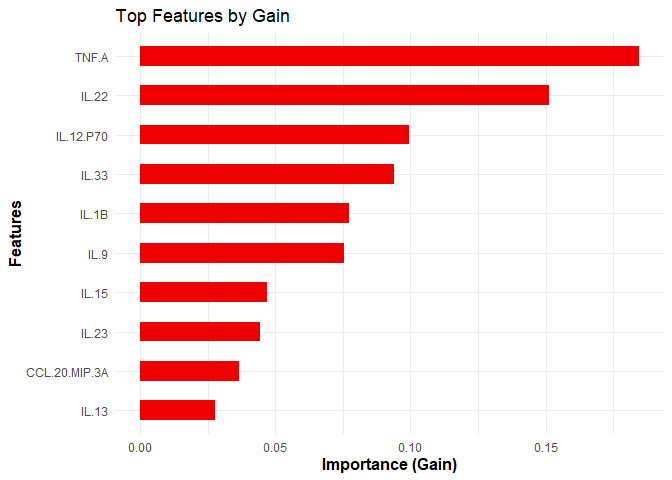
# Using Random Forest for classification
cyt_rf(
data = data_df,
group_col = "Group",
k_folds = 5,
ntree = 1000,
mtry = 4,
run_rfcv = TRUE,
plot_roc = TRUE,
verbose = FALSE
)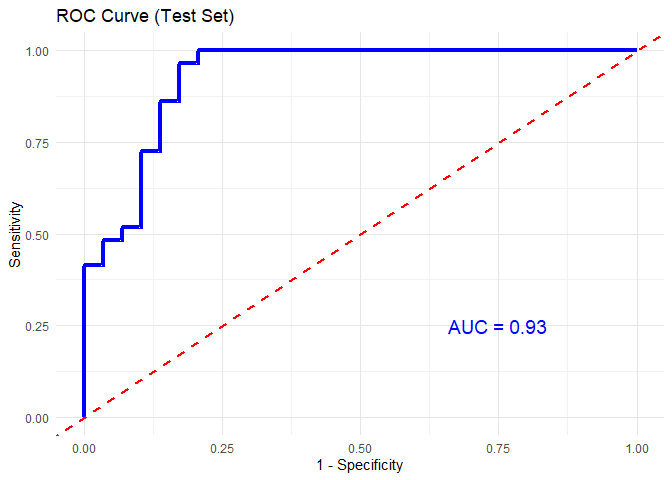
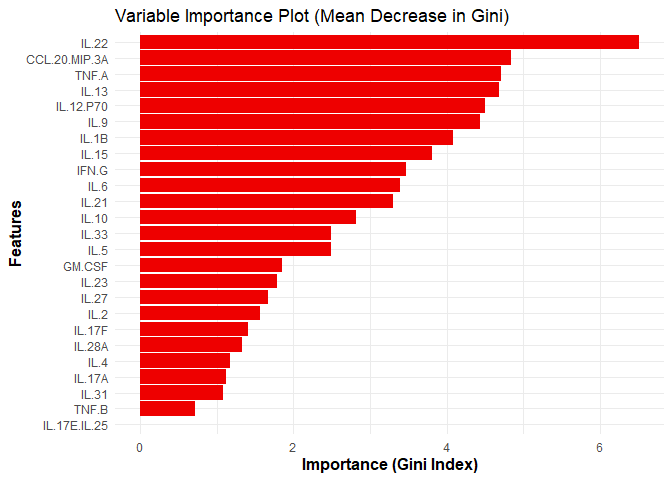
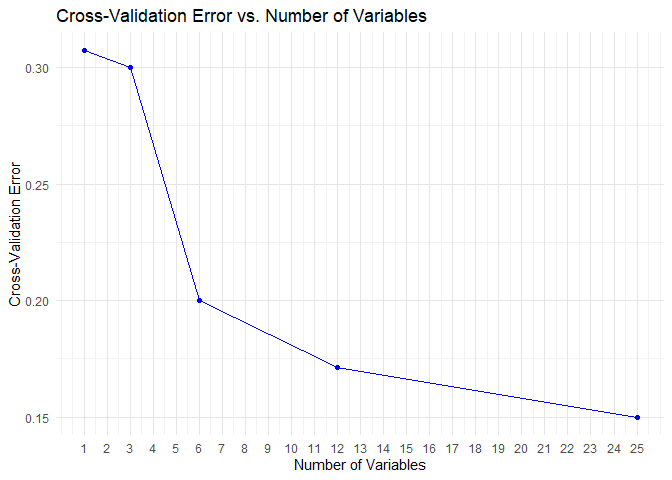
These binaries (installable software) and packages are in development.
They may not be fully stable and should be used with caution. We make no claims about them.
Health stats visible at Monitor.